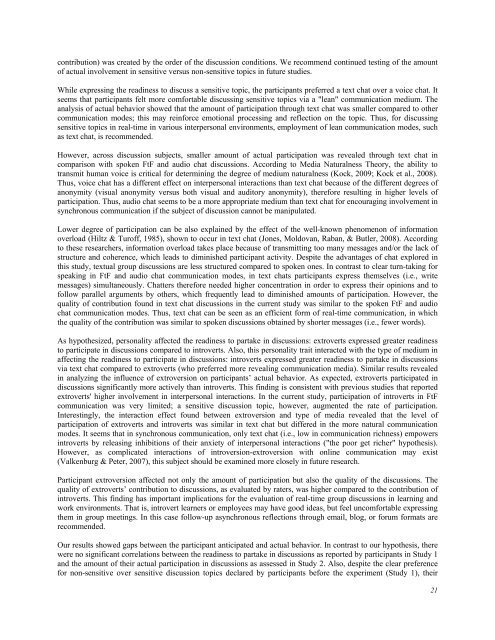April 2012 Volume 15 Number 2 - Educational Technology & Society
April 2012 Volume 15 Number 2 - Educational Technology & Society
April 2012 Volume 15 Number 2 - Educational Technology & Society
You also want an ePaper? Increase the reach of your titles
YUMPU automatically turns print PDFs into web optimized ePapers that Google loves.
contribution) was created by the order of the discussion conditions. We recommend continued testing of the amount<br />
of actual involvement in sensitive versus non-sensitive topics in future studies.<br />
While expressing the readiness to discuss a sensitive topic, the participants preferred a text chat over a voice chat. It<br />
seems that participants felt more comfortable discussing sensitive topics via a "lean" communication medium. The<br />
analysis of actual behavior showed that the amount of participation through text chat was smaller compared to other<br />
communication modes; this may reinforce emotional processing and reflection on the topic. Thus, for discussing<br />
sensitive topics in real-time in various interpersonal environments, employment of lean communication modes, such<br />
as text chat, is recommended.<br />
However, across discussion subjects, smaller amount of actual participation was revealed through text chat in<br />
comparison with spoken FtF and audio chat discussions. According to Media Naturalness Theory, the ability to<br />
transmit human voice is critical for determining the degree of medium naturalness (Kock, 2009; Kock et al., 2008).<br />
Thus, voice chat has a different effect on interpersonal interactions than text chat because of the different degrees of<br />
anonymity (visual anonymity versus both visual and auditory anonymity), therefore resulting in higher levels of<br />
participation. Thus, audio chat seems to be a more appropriate medium than text chat for encouraging involvement in<br />
synchronous communication if the subject of discussion cannot be manipulated.<br />
Lower degree of participation can be also explained by the effect of the well-known phenomenon of information<br />
overload (Hiltz & Turoff, 1985), shown to occur in text chat (Jones, Moldovan, Raban, & Butler, 2008). According<br />
to these researchers, information overload takes place because of transmitting too many messages and/or the lack of<br />
structure and coherence, which leads to diminished participant activity. Despite the advantages of chat explored in<br />
this study, textual group discussions are less structured compared to spoken ones. In contrast to clear turn-taking for<br />
speaking in FtF and audio chat communication modes, in text chats participants express themselves (i.e., write<br />
messages) simultaneously. Chatters therefore needed higher concentration in order to express their opinions and to<br />
follow parallel arguments by others, which frequently lead to diminished amounts of participation. However, the<br />
quality of contribution found in text chat discussions in the current study was similar to the spoken FtF and audio<br />
chat communication modes. Thus, text chat can be seen as an efficient form of real-time communication, in which<br />
the quality of the contribution was similar to spoken discussions obtained by shorter messages (i.e., fewer words).<br />
As hypothesized, personality affected the readiness to partake in discussions: extroverts expressed greater readiness<br />
to participate in discussions compared to introverts. Also, this personality trait interacted with the type of medium in<br />
affecting the readiness to participate in discussions: introverts expressed greater readiness to partake in discussions<br />
via text chat compared to extroverts (who preferred more revealing communication media). Similar results revealed<br />
in analyzing the influence of extroversion on participants’ actual behavior. As expected, extroverts participated in<br />
discussions significantly more actively than introverts. This finding is consistent with previous studies that reported<br />
extroverts' higher involvement in interpersonal interactions. In the current study, participation of introverts in FtF<br />
communication was very limited; a sensitive discussion topic, however, augmented the rate of participation.<br />
Interestingly, the interaction effect found between extroversion and type of media revealed that the level of<br />
participation of extroverts and introverts was similar in text chat but differed in the more natural communication<br />
modes. It seems that in synchronous communication, only text chat (i.e., low in communication richness) empowers<br />
introverts by releasing inhibitions of their anxiety of interpersonal interactions ("the poor get richer" hypothesis).<br />
However, as complicated interactions of introversion-extroversion with online communication may exist<br />
(Valkenburg & Peter, 2007), this subject should be examined more closely in future research.<br />
Participant extroversion affected not only the amount of participation but also the quality of the discussions. The<br />
quality of extroverts’ contribution to discussions, as evaluated by raters, was higher compared to the contribution of<br />
introverts. This finding has important implications for the evaluation of real-time group discussions in learning and<br />
work environments. That is, introvert learners or employees may have good ideas, but feel uncomfortable expressing<br />
them in group meetings. In this case follow-up asynchronous reflections through email, blog, or forum formats are<br />
recommended.<br />
Our results showed gaps between the participant anticipated and actual behavior. In contrast to our hypothesis, there<br />
were no significant correlations between the readiness to partake in discussions as reported by participants in Study 1<br />
and the amount of their actual participation in discussions as assessed in Study 2. Also, despite the clear preference<br />
for non-sensitive over sensitive discussion topics declared by participants before the experiment (Study 1), their<br />
21

















